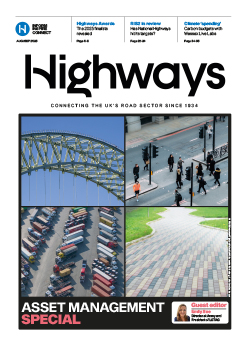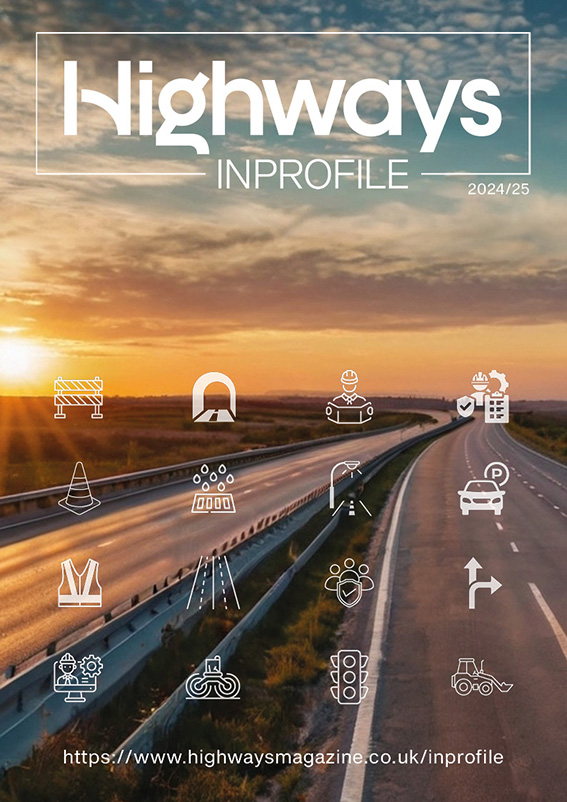Highways reports from the M48 Severn Bridge, where a scheduled inspection of the Grade 1 listed structure has been taking place since last summer.
When looking at the Severn Bridge, there is the big picture and the fine detail.
The big picture is that the 1.6km bridge is one of four structures that take what is now the M48 across the Severn estuary. The central span, between the four towers from which hang the cables that hold it up, as well as shorter spans at each end, is nearly 1km.
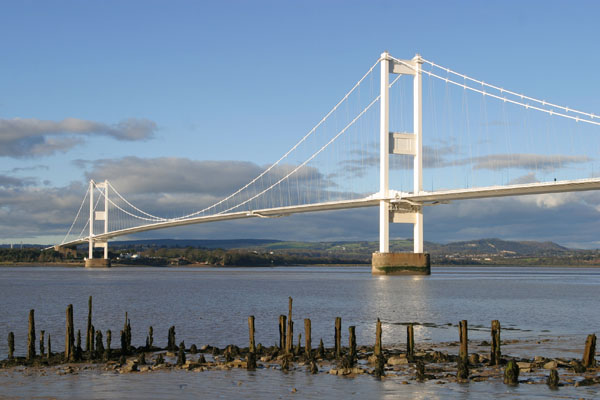
Chris Pope, project manager for National Highways, describes the location as a ‘horrible environment for steel’, which is unfortunate as it is the material used both for the bridge deck itself and the cables.
Mr Pope says: ‘Most of the bridge is fine, because we have well-established paint systems that protect the steel.’ However, this does not apply to the cables.
The structure is one of the UK’s only parallel strand bridges, with the 511mm diameter main cable cables made up of 8,322 parallel 5mm wires. These are the fine detail that National Highways needs to keep on top of.
When it was built, the bridge was considered to be the Concorde of the bridge world, with an aerodynamic deck to reduce lift under high winds, but the threat of cable corrosion during the life of the structure was apparently not foreseen.
It opened in 1966 and carried the M4, serving this role for three decades until a new bridge – named the Prince of Wales crossing after the future and now king – opened in 1996.
When the private finance arrangement expired under which the new bridge was built and both bridges were maintained, responsibility for their maintenance – and cost – fell to National Highways.
While the Government dropped the tolls over the bridges – announced suddenly during the 2017 election – funding for the Severn Bridges is now provided to National Highways, under a protocol agreement.
Inspection and maintenance of the two bridges and the nearby M5 Avonmouth Bridge are now the responsibility of Amey Transport Infrastructure under a 15-year contract worth £16m a year that began in 2020. Amey is also given capital works, such as the current inspection.
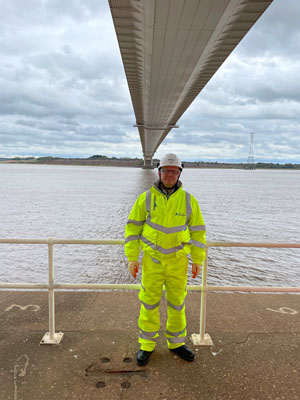
Mr Pope (pictured, right) says the arrangement works very well for National Highways in cases such as this ‘where access is everything’.
In a parallel strand cable, it is the spaces between the wires that allow moisture to enter and cause corrosion.
New US guidance published in 2004 prompted an inspection in 2006, which first discovered the corrosion. The inspection put the wires into four categories according to the level of corrosion and uncovered significant corrosion. A lot was at level 4, and a lot of this was in the middle of the two long cables that run from its four towers.
This position at the mid span of cable is not just where water will inevitably congregate but, as Mr Pope says, the part of the cable that is doing ‘the least amount of work’, which he says is a ‘happy coincidence’.
National Highways says that even with this level of corrosion the bridge remains capable of supporting nose-to-tail HGVs on one lane in each direction – if such a thing should ever occur. To prevent this happening across all four lanes, a weight limit was put in place for lanes two in each direction.
As Highways reported last February, the temporary traffic regulation order that provided the legal basis for this restriction was mistakenly allowed to lapse. A new order was made in March. You are welcome.
Acoustic monitoring was put in place alongside a dehumidification system, with the cables being wrapped in elastomeric material.
The acoustic monitoring system can detect wire breaks and which section of the cable occur in National Highways says it has detected 215 confirmed wire breaks since it was installed in 2006, of which 29 are since the last cable inspection in 2016.
Originally a Japanese invention, dehumidification technology for bridge cables blows dried air along the length of the cables, making use of the same gaps that allowed the moisture to enter. The theory is that corrosion does not occur below 40% humidity – a level that is easily being achieved.
Monitoring of the air as it leaves at the other end provides an indication of the level of humidity. Dried air is created with in 4 plant rooms inside the bridge deck. Initial a very low humidity level was originally used, but this is considered unnecessarily energy intensive now the cables have been dried out. National Highways says that, although energy prices have increased, the cost of using the dehumidification system is just a fraction of the running costs of the bridge.
Mr Pope says that despite acoustic monitoring, ‘we need to be looking at it’ (the bridge). Cable inspections were instituted, with the first taking place in 2006 as the Highways Agency was keen to get an early picture of the cables’ condition. A second inspection took place in 2010 and a third in 2016, with the next one currently taking place.
National Highways has spent £30m on these works since 2006, with the latest inspection costing around £5m.
Amey has a large maintenance team continuously present on the English side of the bridge and has brought in VolkerLaser to carry out this round of inspection, which began in June.
Eight panels are being opened for inspection – four on the upstream side and four on the downstream side. A panel is the section of cable between two of the hangers that transfer the weight of the deck to the cable.
 To facilitate the inspections, enclosed work areas are created at various points along the cable. Some, which Highways saw inside during the visit, are on scaffolds on the deck itself, accessed from the cantilevered cycle lanes that run outside each carriageway, while others are on gantries attached to the cables themselves.
To facilitate the inspections, enclosed work areas are created at various points along the cable. Some, which Highways saw inside during the visit, are on scaffolds on the deck itself, accessed from the cantilevered cycle lanes that run outside each carriageway, while others are on gantries attached to the cables themselves.
To protect the on-deck scaffolds, lane one of each carriageway was closed for the duration of the works, with Varioguard steel barriers, procured from the administrators of Cleveland Bridge UK. During the first inspection, concrete barriers were used – a mistake that was not repeated.
Since the new crossing was built, traffic on the Severn Bridge is relatively light – but it is not the only threat. The middle of the Severn Estuary is also a horrible place for inspections, exposed as it is to high winds.
The original intention was to inspect the high-level sections during the summer but this was put back by bad weather, with work focusing on lower levels. Indeed, when Highways visited, the winds were too high for a trip to the top of one of the towers just but low enough to allow a viewing of an enclosed on-deck scaffold.
A trip to one of the two concrete bases that each hold up two of the four towers was however possible – and sufficiently hairy. While a lift takes you down some of the way onto a steel platform, there is still a climb of around 10 metres down an exposed vertical metal ladder, with the wind seemingly trying to blow you off every careful step of the way.
To inspect the cables, technicians first hammer nylon wedges in between the wires, following this up with a wooden wedge. This process, which is said not to damage the wires, allows a visual inspection of wires within the core of the cable.
Contamination from the red lead paste that was put on previously as part of the protection system presents a potential hazard for workers, who wear disposable paper PPE on top of their more robust orange PPE.
When broken or other cables are removed for inspection, they tend to coil up, returning to the state they were in before installation. At present, inspections had been carried on six panels, with a seventh in progress. So far, 94 new wire breaks had been found across the three panels where, with inspection of a fourth panel is progress at that time. While these wires were newly discovered, that does not mean that they had broken recently.
Broken wires are held in place by the wires around them, falling out when the cable is opened. The 2006 inspection discovered 84 wires that had broken since the opening in 1966, with the cumulative number from opening to 2010 being somewhere around 120. This had only increased by another 21 by 2016.
The latest figure of 94 suggests that any apparent deceleration has not been sustained. However, Mr Pope says: ‘The site work isn’t really about finding wire breaks – wire breaks are important but the crucial thing is about finding the levels of corrosion.’
National Highways says corrosion levels are ‘to our expectations’. Mr Pope adds that one panel has been opened at each inspection since 2006 and is in ‘the same condition as we first found it’, which he says shows that ‘our mitigation and dehumidification has worked very, very well’.
Similarly, he says National Highways does not try to match wire breaks found on site with those that have been recorded by monitoring. The latter have already been confirmed by both the system’s software and an engineer.
He adds, however: ‘We have used the acoustic monitoring results to help target which panels we go into. One with a number of wire breaks was an obvious place to have a look but when we went in there, we’ve not found anything we weren’t expecting.’
National Highways says acoustic monitoring does allow it to monitor the rate of change, ‘and if we were detecting an increase of breaks all at once, we could investigate and identify the cause’. Mr Pope adds in relation to the 29 breaks detected since 2019 that the level of breaks has ‘not got anywhere near’ the level that would trigger an event under the company’s monitoring specification.
Samples are also taken and sent for strength and chemical analysis in the lab, although there is a limit to how far this can be done within the core of the cable. Mr Pope says that although some analysis was during the last inspection to differentiate between corrosion and hydrogen embrittlement, ‘fundamentally the cause [of wire breaks] is that corrosion is giving us pitting, so within the wire you are losing a cross section’.
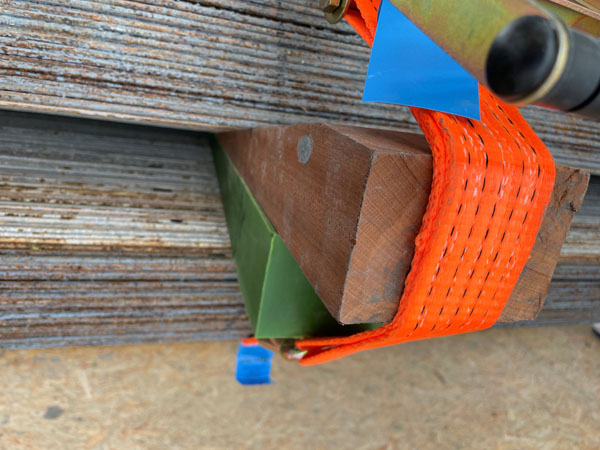
He adds that the dehumidification system is also adding vapour phase corrosion inhibitors and that testing has shown this to be present on the cable wires.
Data from the inspection is input into modelling software that has had to be slightly tweaked to take into account of the specifics of the bridge’s design.
Over the years, the contract for the inspections has passed from major firms in the sector, with consultants engaged to check the calculations. Atkins, who previously carried out an inspection are the checkers this time. Mr Pope says the body of knowledge that has accumulated, which allow it to quickly put together a panel – as happened in 2006 – ‘if, God forbid, we did find a problem’.
Broken wires can be mended and the same tension put in via a turnbuckle. The process of ensuring that the repaired wire is put under the same tension as before is a relatively basic one, involving lines being drawn in pen across the parallel wires so that the re-tensioned wire returns to the same position.
After inspection of a panel has been completed, a compactor will return the cable to its pre-wedge shape and it is coated with zinc paste and re-enclosed.
Mr Pope sums up: ‘We’re not trying to kid ourselves. At points, this is quite a badly corroded bridge. But with the mitigation measures, we’re OK. Ultimately, we’re satisfied that it’s still safe to operate.’

